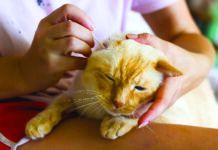Q. I have worked for local spay/neuter non-profit organization for the past 16 years, and we deal primarily with stray and feral cats. Over the past two years, we have been seeing a condition that is commonly referred to as “puffy pad disease.”
We would like to know what information you can share with about this malady — how and why it starts, how it may be treated and its prognosis.
Thomasina Patton
A. Dear Thomasina: You’re describing a condition in cats called feline plasma cell pododermatitis (FPP), and it is sometimes called “Pillow Foot.” I haven’t heard it referred to as “puffy pad disease,” but the name is appropriate because the foot pad of the affected foot (or feet) develops a characteristic swollen, puffy appearance.
Pododermatitis means “inflammation involving the skin on the foot.” In this case, the inflammation is due to infiltration of the pad with plasma cells, which are a type of cell of the immune system. The cause of FPP remains unknown, although the fact that immune cells are involved suggests some sort of overstimulation of the immune system.
FPP usually involves more than one foot. No particular breed is predisposed, nor is there any particular age or sex predilection. Clinical signs can vary from cat to cat. Some cats aren’t bothered by it, while other cats may limp and show signs of pain when the foot is examined. Blood tests often show an elevated number of lymphocytes as well as an increased level of globulin — a type of protein — in the bloodstream. A definitive diagnosis is obtained by biopsy of an affected pad, but this usually isn’t necessary, given the characteristic appearance with this disorder.
Because immune stimulation is suspected to be involved in the disease, treatment involves suppressing the immune response. Initially, the drug doxycycline is prescribed. Although doxycycline is an antibiotic, it does modulate the immune system, and most cats respond well to the treatment.
Cats that show a poor response to doxycycline can be given a steroid such as prednisolone. Steroid treatment is usually very effective in controlling the disorder. In some patients, food hypersensitivity has been associated with FPP, and treatment with a hypoallergenic diet may cause improvement in the condition. The course of FPP can vary greatly. In some cats, the condition resolves spontaneously, while other cats may require lifelong therapy.
Arnold Plotnick, DVM, MS, ACVIM
Catnip contributor




Hi there,
Can FPP effect only one digital pad? My 12 week old kitten developed a swollen toe bean with some crusting around it. Vet gave him Amoxicillin to try first in case of an infection. She believes though, that is immune mediated condition. She hesitates giving the steroid to such a young kitten unless it’s the only option. I agree. Would modulating the immune system with Doxycycline offer benefits? He’s not in any pain, and had I not been examining him one day, would never have known. He’s tearing around the house like a champ.
Thank you for your input.
J Cummins
Guess you sorted things out yourself, cause clearly no one bothered to answer you
Sad you waited a year without a comment, what a crap site